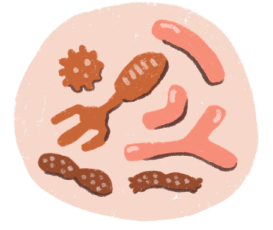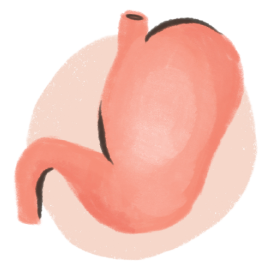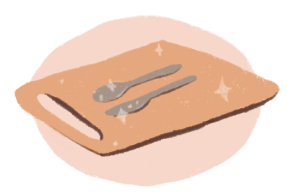Unveiling the Truth: Is Raw Food Safe for Your Pet?

by Dr Nicole Rous, Integrative Vet

Pet owners are constantly bombarded with conflicting information about what's the best diet to feed. One hotly debated topic is whether raw food diets are safe for pets. Advocates tout the benefits of feeding raw (full disclosure I’m pro-raw!), while sceptics raise concerns about potential risks. So, where does the truth lie? Let's delve into the top concerns and bring in the science to help you make an informed decision about what is best for your pet.
Concern 1: Bacterial contamination

The idea of feeding raw can evoke fear in pet parents (and vets!) for various reasons but the most prominent concern is the potential for bacterial contamination. Raw meat, by its nature, has the potential to harbour harmful pathogens such as Salmonella, E. coli, and Listeria. These bacteria can not only pose a risk to pets but also to the humans who handle the food.
Did you know that other food also carries bacteria? Even the convenient ready-to-eat salads we all love, have been found to carry Salmonella in one third of them (Lepecka et al. 2022). Carnivores (both cats and dogs!) digestive systems are naturally equipped to handle raw meat, with shorter digestive tracts and higher stomach acidity compared to humans. These physiological adaptations enable them to digest and eliminate potential pathogens more effectively, however, we need to remember that bacteria is everywhere, it’s normal and good for us. It’s only the harmful or pathogenic bacteria we need to worry about.
One of the reasons I’m pro raw or fresh food is that creating a strong and healthy gut will help defend against pathogens whether they come from the environment or food. Feeding a balanced raw diet is much friendlier on the gut than a highly processed one. A highly processed diet creates a leaky gut which triggers inflammation and the immune system, making our pets more susceptible to bad bacteria if they’re faced with them.
Concern 2: Immune compromised or vulnerable family members

As we’ve just mentioned, a healthy gut will help defend against pathogens. This is because 70% of our immune system is in our gut so there is naturally a concern about the safety of raw diets in households with immunocompromised individuals or vulnerable populations, as they may be at higher risk of contracting foodborne illnesses. This is one concern that I can appreciate the stress around but I would emphasise that safe food handling practices are imperative no matter what food you or your pets are eating. The highest population that end up in an emergency with gastro from pet food are toddlers playing with kibble in the dog bowl!
Concern 3: Won’t they miss out on nutrients?

One of the major reasons pet parents choose processed diets is for the ‘peace of mind’ that they’re providing a complete and balanced diet. However, studies of processed diets show as little as 38% of kibble and 9% of tinned food actually meet minimum nutrition requirements (Davies et al, 2017). Not only does the heavy processing in many of these diets cause such a significant loss of nutrients resulting in imbalances, the nutrients are often replaced with synthetic alternatives that may be less bioavailable.
Critics of raw diets argue that homemade raw diets may lack essential nutrients, leading to nutritional deficiencies or imbalances over time. This concern does have weight and is especially pertinent for pet owners who may not have the expertise to formulate a nutritionally complete raw diet for their pets. This is an easy work-around though as we have companies, like Big Dog, that create complete and balanced raw diets for pets. As a vet I am personally more comfortable with pet parents choosing a pre-made complete and balanced diet than DIY at home (even though I know it can be done amazingly well!).
Concern 4: Recalls

One of the primary arguments against raw feeding is the occurrence of recalls associated with raw pet food products, again, back to the bacterial contamination concern. While it's true that there have been recalls due to contamination issues in some raw diets, it's essential to put these events into perspective. Recalls are not exclusive to raw pet food; commercially processed pet foods, including kibble and canned varieties, have also been subject to recalls due to contamination concerns. To date there are MANY more recalls from Salmonella contamination in kibble compared to raw diets. The key lies in understanding the factors contributing to these incidents and the measures taken to mitigate risks.
In recent years, advancements in food safety protocols and manufacturing practices have improved the safety of raw pet food products. Many reputable raw food manufacturers adhere to rigorous quality control standards, including frequent testing for pathogens and implementing HACCP (Hazard Analysis and Critical Control Points) plans to minimise contamination risks. Ensuring you’re sourcing raw pet diets from HUMAN grade meat (or ingredients from the human supply chain) will reduce the risk of contamination due to the stricter controls than PET grade meat. However, it's essential to emphasise the importance of proper handling and hygiene practices when feeding raw to minimise the risk of contamination.
Guidelines for Safe Raw Feeding:

Hopefully this article gives you peace of mind to consider feeding a balanced raw diet. While there are valid concerns surrounding bacterial contamination and nutritional adequacy, a well-planned raw diet can offer numerous benefits for your pet's health and vitality.
Here are my recommendations to ensure the safety and nutritional adequacy of a raw diet:
- Choose reputable sources: Opt for commercial raw food products using human grade meat and from reputable manufacturers with a track record of stringent quality control measures. Look for brands that undergo regular testing for pathogens and adhere to industry standards for food safety.
- Practice proper hygiene: Handle raw meat with care to prevent cross-contamination and minimise the risk of foodborne illness. Thoroughly wash hands, utensils, and food preparation surfaces after handling raw meat.
- Monitor your pet's health: Keep a close eye on your pet's overall health and well-being after transitioning to a raw diet. Support their gut with a good probiotic during the transition. Look out for any signs of digestive upset, food intolerances, and consult with your veterinarian if necessary.
About the Author - Dr. Nicole Rous

Dr. Nicole Rous completed her degree with Honours from the University of Sydney in 2008. She initially worked in the UK before returning to small animal practice in Melbourne, Australia. Dr. Nicole has a keen interest in animal reproduction and has been granted Membership with the Australian and New Zealand College of Veterinary Scientists in this specialty. She is also passionate about complementary therapies such as massage and enjoys discussing ways to enhance pets' overall well-being and quality of life.
In August 2021, Dr. Nicole joined the Mont Albert Veterinary Surgery team as a director and continues to provide exceptional care to her patients. She is dedicated to utilising her knowledge and experience to assist pets in living longer, healthier, and happier lives.
Dr. Nicole's commitment to providing natural and holistic health practices for pets inspired her to establish Shy Tiger, a company that offers natural pet products made from premium ingredients sourced primarily from Australian farms and producers. Her expertise in natural health practices and dedication to providing excellent care to her patients make her a reliable partner for pet owners in Melbourne and beyond.
If you liked this article, sign up to our Big Dog Fam Mail to receive more great pet health and happiness advice.
References
Lepeck A, Zielinska D, Szymanski P, Buras I and Kolozyn-Krajewska D. 2022. Assessment of the microbiological quality of ready-to-eat salads - are there any reasons for concern about public health? Int J Environ Res Public Health. 19.1582. Article
Davies M, Alborough R, Jones L, Davis C, Williams C and Gardner DS. 2017. Mineral analysis of complete dog and cat foods in the UK and compliance with European guidelines. Sci Rep. 7. 17017. Article
